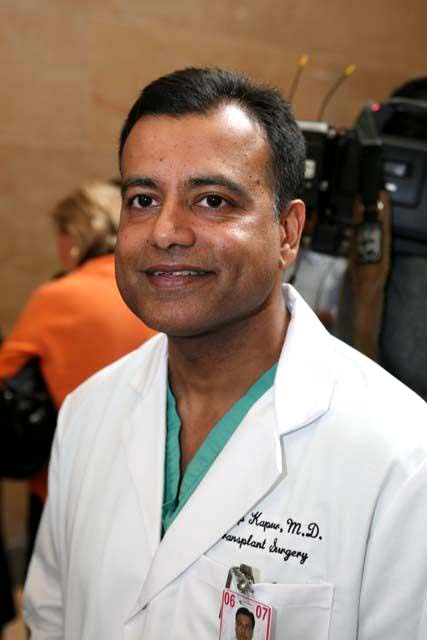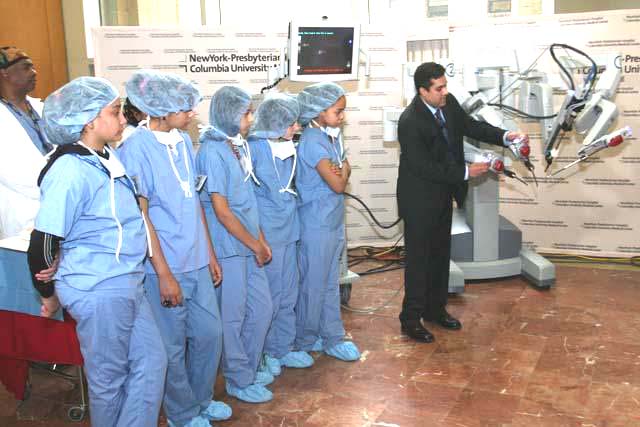A walk through New York-Presbyterian Hospital’s mini medical city….
The meandering, thundering steel dragon, also known as the No. 1 subway train, rushed on, its belly filled with countless strugglers and dreamers all commuting to the gritty Upper West Side. At crowded 165th street, it disgorged a huge chunk of humanity – patients and families, small children, doctors and nurses – all headed to the New York- Presbyterian Hospital, one of the great teaching hospitals in the city.
With so many human lives interlinked with its services, you see that this hospital is the lifeblood, the nerve center of the urban community. Indeed, it is a landmark in New York, a blending of past, present and future as it provides succor to patients and hope in the form of some of the most cutting edge technologies in medicine.
As I walked from the subway station, I fell into step with a nurse who was headed to the hospital. She mentioned that she had worked there for 27 years, and recalled that a parking lot once stood where one of the gleaming new buildings now has arisen.

Indeed, the New York-Presbyterian Hospital has changed and metamorphosed over the years so that it is now actually five hospitals in one: it is one of the most comprehensive university hospitals in the world, with leading specialists in every field of medicine.
A mini medical city has arisen in the span of an avenue block and several streets, and around it this Washington Heights neighborhood has flourished. It shows the power of collaboration for what was once a single hospital has multiplied into several. It comprises of New York-Presbyterian Hospital/Columbia University Medical Center, New York-Presbyterian Hospital/Weill Cornell Medical Center, a branch in Westchester, the Allen Center in north Manhattan, and the Morgan Stanley Children’s Hospital. All of them are affiliated with two Ivy League medical institutions, Columbia University College of Physicians and Surgeons, and Weill Medical College of Cornell University.

And that brings us to the physicians, for what makes a great hospital is great physicians. The hospital is #1 in the New York City metropolitan area and #6 in the nation, according to U.S. News Media Group’s 2009-2010 edition of America’s Best Hospitals.
Interestingly enough, the hospital has several staff members from physicians to trainees who are of Indian origin. There are several physicians of Indian descent who are leading the charge here and we spoke with some of them to learn of the cutting edge technologies that are being employed.

Dr. Laxmi Baxi was probably one of the first Indian physicians to work there and has been at the hospital for 32 years. Baxi, who is the attending OB-Gyn at the Sloan Hospital, Columbia University Medical Center, is also a professor of clinical obstetrics and gynecology at Columbia University. Baxi, who specializes in high risk pregnancies, has been listed amongst the best doctors in New York by New York Magazine for the past 18 years and amongst the best doctors in America for the past five years.
“When I joined, I was the only Indian in the entire hospital in the faculty of OB-Gyn,” she recalls of those days back in the 70’s. “There was only one female and she was about to retire and there was no other woman in the department.”
Baxi, who had her education at KEM University and Seth GS Medical College in Mumbai, has worked with many distinguished physicians on the faculty at the New York Presbyterian, including Dr. Henry Clay Fricke. She says: “They were people who had seen the world and they had great respect for people who came from outside, and they liked my training and the work I had done.”
“My role is recognizing the complications and problems in pregnancies and having a strategy on how to deal with it, and understanding how it will impact the future of the family,” she says. At the hospital there is the opportunity for collaboration with research scientists, and so she is able to expose the patients to the latest developments and thus offer them better care for themselves and their families.

One of the most dramatic cases she remembers is of a patient from London who had been told she should write off the pregnancy. Baxi identified that the fetus had heart block and was in failure, and with astute management, the pregnancy was carried to near term. Says Baxi: “The baby – no longer a baby – is one of the smartest and brightest young girls today.”
She finds that the difficult pregnancies are often a symptom of other health problems such as lupus or bleeding, clotting or genetic disorders which her patients were not aware of. She is almost an internist amongst ob-gyns, and likes the role: “I like to be a detective and it gives me a high to identify problems, because now we can go for it and have a good outcome. I like to pass this to my students too so we have better doctors tomorrow.”
The Chief of Transplant Surgery and Director of Kidney and Pancreas Transplant programs at New York-Presbyterian Hospital-Weill Cornell Medical Center is also an Indian, Dr. Sandip Kapur. Kidney transplants are vital as in the US alone there are over 90,000 patients waiting for a donor. His clinical expertise is in kidney, whole organ pancreas and islet cell transplantation, and he’s the first and only surgeon in the tri-state area to perform a successful islet-cell transplant to cure Type 1 diabetes.
“Our particular expertise is in offering all known opportunities for transplantation,” he says. “We’ve had very good success in innovating different programs for living donation.”

Kapur, whose family hails from Delhi, is also an Associate Professor of Surgery at Weill Cornell Medical College and an Associate Attending Surgeon at New York -Presbyterian Hospital-Weill Cornell Medical Center. He heads the oldest kidney transplant program in New York State, one of the highest volume programs in the country, and is a pioneer in developing innovative strategies that allow transplants in difficult situations. An example is the ABO program where a patient is able to receive a kidney from a donor when blood types don’t match.
Kapur led the Weill Cornell transplant team that performed the nation’s first three-way living-donor kidney transplant surgery, and this could revolutionize the field of transplants. “One of the things that’s developed over the last year is the concept of NEAD – the never ending altruistic donation – what’s involved is people offering to donate a kidney to someone who they don’t know,” says Kapur.
“With an altruistic donor, you can create a chain of transplants where at the end there’s always a donor to start another chain. Mathematically it becomes a very powerful mechanism for increasing the donor pool. We’ve been able to transplant almost 70 percent of our waiting list which would otherwise not have been possible.
He adds, “Without these opportunities many of these people would languish on dialysis for five, six, seven, eight years and potentially have a shorter life span because of it.”

Another area of cutting edge technology is the field of robotic surgery where two of the leading Indian physicians are Dr. Ash Tewari and Dr. Ketan Badani. Prostate cancer is the second most common cancer in America, affecting 1 in 6 men, and the New York Presbyterian is one of only three hospitals in the US which are equipped to treat prostate cancer with robotic surgery.
For prostate cancer patients, the robotic approach has numerous improvements over conventional prostatectomy, including smaller, less painful incisions, reduced blood loss and scarring, shorter hospital stay, excellent cancer control, early return of urinary function and low risks of impotency.
Tewari is the Director of Robotic Prostatectomy and Prostate Cancer-Urologic Oncology Outcomes at Brady Urology Institute at the Department of Urology, and an Associate Professor of Urology. He is also an Associate Professor of Public Health and Outcomes in the Department of Public Health and Outcomes at The Weill Medical College of Cornell University.
He credits his early medical training in India for preparing him for his posts in some of the premier medical institutions in the US, and has performed more than 2,000 robotic procedures for prostate cancer, and helped develop award-winning techniques that reduce potential risks of surgery, including incontinence and impotence.
Tewari, who hails from Kanpur, was recently named Director of Robotic Surgery at New York-Presbyterian Hospital/Weill Cornell Medical Center where a $ 3 million gift established the LeFrak Center for Robotic Surgery which supports research and a center to train physicians in robotic surgical techniques. The state of the art equipment includes the da Vinci Surgical System by Intuitive Surgical, which comprises a surgeon console and a patient-side robotic mechanism with an endoscopic camera and miniaturized surgical instrumentation.
As Tewari explains, in prostate cancer surgery, this equipment improves the ability of the surgeon to operate around muscles and delicate nerves, thus ensuring a better outcome for patients. Tewari himself was trained by Mani Menon, MD who pioneered the field of robotic urology and developed the VIP technique of Robotic Prostatectomy.
He says, “There’s always a human side of prostate cancer and one of the most rewarding part of this career is that you really can make a difference in patients who have early prostate cancer, for the key is to find this cancer early enough so you can get them back to their quality of life and the life expectancy that they deserve.”
While Tewari is at the Weil Cornell Medical Center, Dr. Ketan K. Badani, is the Director of Robotic Surgery at New York-Presbyterian Hospital/Columbia University and Assistant Professor of Urology at Columbia University.
“The most satisfying part is having something that we think will help patients, trying it and finding that it actually does help them,” says Badani, who was born and grew up in the US. He is one of only a few surgeons in the world who has performed over 1000 robotic surgeries, and has published landmark articles on robotic prostatectomy and enhanced nerve-sparing techniques to preserve sexual function in patients.
“The nice thing is that here is a technology that is actually revolutionizing the way we treat prostate career, solely based on technological advancement,” he says. “My generation of people is more technologically involved, and that’s where my interests lie, so combining medicine, technology and surgery is a perfect fit for me.”
Indeed, it will be intriguing to see where the next generation of physicians takes research and innovation in this new technological age.
On a lighter note, the hospital is certainly encouraging the young ones! More than a dozen students enrolled in New York-Presbyterian Hospital’s Lang Youth Medical Program tested the capabilities of the new robotic surgical machine which allows physicians to conduct prostate and kidney procedures using high-definition 3-D video for improved clarity and detail. The young future surgeons manipulated the arms of the da Vinci System to move, unwrap and sort candies – surgery was never so sweet!
In fact, the Lang Youth Medical Program of Morgan Stanley Children’s Hospital of New York-Presbyterian is a six-year science education and mentoring program to motivate future scientists and physicians. Students, still in their teens, get to observe surgeries and go on medical rounds, and are also given mentoring, internships and tuition assistance for a career in science or medicine. It looks like the future of medicine is in good hands.
A HUNDRED YEAR OLD STORY…
It all started with the merger of The New York Hospital and The Presbyterian Hospital, both respected names in New York. In fact, over the years, some of the noted medical advances have been due to physicians or scientists from these hospitals, from the development of the Pap test for cervical cancer to the synthesis of penicillin to the first successful embryo-biopsy pregnancy and birth in the U.S. Other firsts include the first clinical trial for gene therapy for Parkinson’s disease, the first indication of bone marrow’s critical role in tumor growth, and the world’s first successful use of deep brain stimulation to treat a minimally conscious brain-injured patient.
The merger of The New York Hospital and The Presbyterian Hospital made possible the development of three, state-of-the-art Centers of Excellence. They include a Gamma Knife Center for the treatment of brain tumors, a comprehensive Liver Transplant Center, and a Lung-Reduction Center for the treatment of severe emphysema and bronchitis.
In fact, it was ranked higher in more specialties than any other hospital in America by the US News and World Report. So what are the specialties of this hospital? Between them, the five facilities include AIDS care, preventive medicine, women’s health, trauma centers, vascular health, digestive diseases, reproductive medicine and minimal invasive surgery, and have been recognized as centers of excellence in many of these disciplines. Being in a university hospital for cutting edge research, the patients benefit from many of the innovations such as research in burn treatment, cardiac ischemia and atherosclerosis, breast cancer, and cystic fibrosis
This mini medical city in one city block is a powerhouse of activity combining everything from out patient clinics to a school of nursing and an eye institute. Old and new buildings merge together. If there is a hundred year old building, there is also the sprightly Children’s Hospital – one of the best in the country – with welcoming Maurice Sedak images on the wall where live entertainment for the children is also piped into the room for patients too sick to venture out. Step out and you find the sounds of the city are all around as cars and buses and pedestrians rush by and new construction for the hospital continues to be built.
The same energy is visible in all the centers of the New York Presbyterian Hospital spread around New York. New centers to be opened include two state of the art heart care facilities.
Recently the hospital initiated myNYP.org which is an online personal health record for patients, a welcome way for patients to be more aware and involved in their own healthcare since it allows them to store medical information from their hospital visits. It is indeed an ongoing story with many more chapters to be written.
© Lavina Melwani

